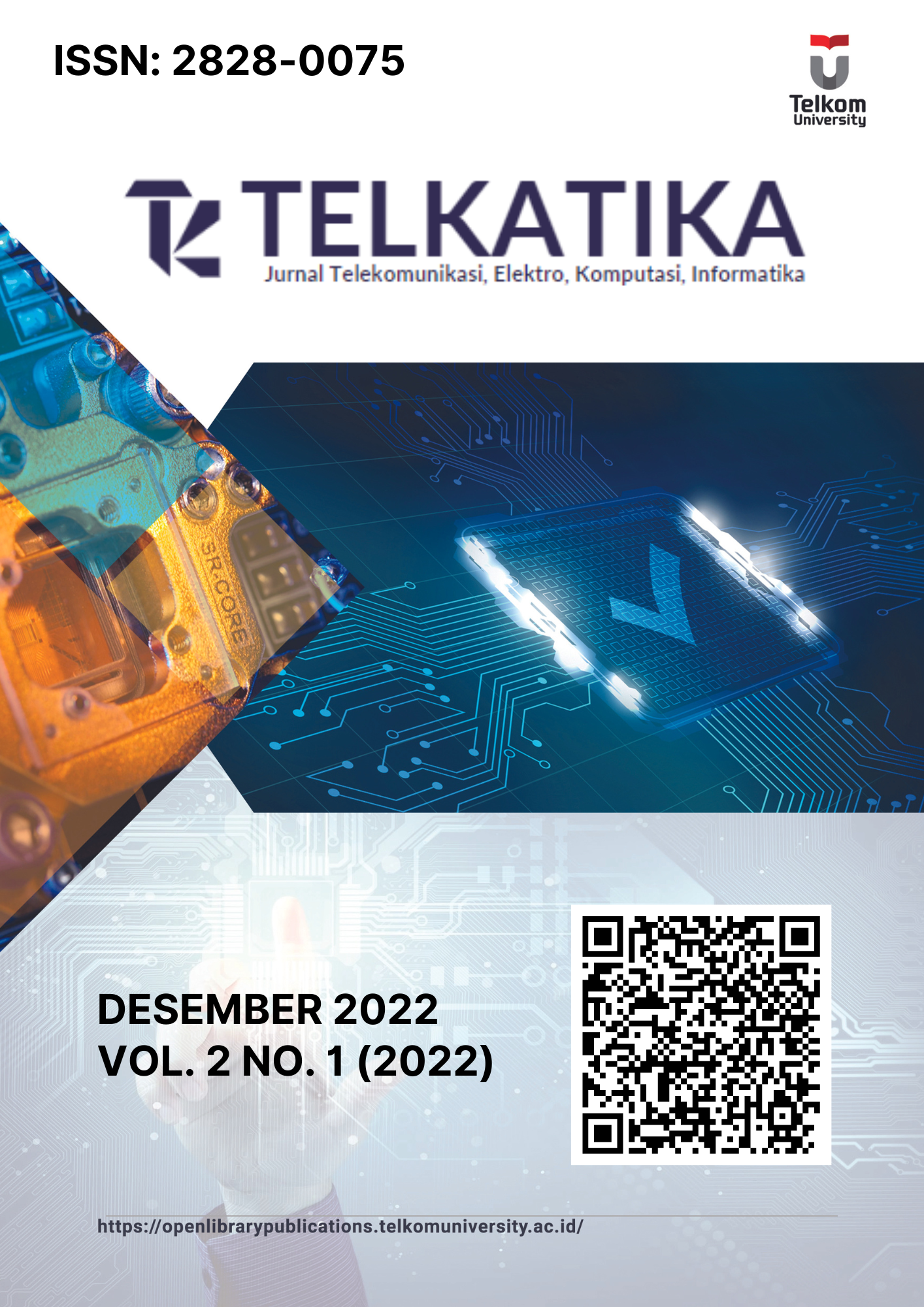DETEKSI SUHU TUBUH DAN PENGGUNAAN MASKER PADA PENUMPANG BUS TRANS METRO BANDUNG DI ERA NEW NORMAL MENGGUNAKAN CONVOLUTIONAL NEURAL NETWORK BERBASIS INTERNET OF THINGS
Abstract
Protokol kesehatan seperti pengecekan suhu dan penggunaan masker pada penumpang Trans Metro Bandung di era new normal saat ini dikontrol langsung oleh pihak Trans Metro Bandung (TMB). Hal ini tentu kurang efisien dari segi waktu dan petugas serta lebih beresiko terhadap Covid-19. Maka dari itu dibutuhkan sistem otomatis yang memanfaatkan teknologi computer vision yang dapat meminimalisir ketidakefisiensian tersebut. Penelitan ini diusulkan dengan merancang sistem deteksi suhu tubuh menggunakan kamera thermal AMG883 dan raspberry pi, serta sistem penggunaan masker yang bersifat contacless menggunakan klasifikasi Convolutional Neural Network (CNN) dengan arsitektur Mobilenetv2. Dataset diambil secara langsung pada bus TMB Koridor 2 Cicaheum- Cibeureum. Data dipisah menjadi 80% training dan 20% validasi. Kemudian data dilatih dan divalidasi untuk diketahui performansinya. Dari hasil pengujian dan analisa diperoleh hasil pengukuran suhu menggunakan AMG8833 lebih akurat yang menggunakan jarak 75 cm. Didapatkan akurasi sebesar 99, 36% dan error sebesar 0, 64%. Dan pada sistem deteksi penggunaan masker, didapatkan epochs terbaik untuk training model, yaitu 200. Training accuracy yang dihasilkan sebesar 0.9299, validation accuracy sebesar 0.9127, training loss sebesar 0.2002, dan validation loss sebesar 0.2573. Sistem deteksi penggunaan masker lebih optimal bekerja pada wajah tampak depan dan juga lebih optimal bekerja pada jarak 75cm, baik itu untuk objek tunggal maupun jamak.
Kata kunci: Trans Metro Bandung (TMB), computer vision, Convolutional Neural Network (CNN), Internet of Things (IoT), AMG8833.
References
P. Studi, “SISTEM PENGUKURAN SUHU TUBUH MENGGUNAKAN CAMERA THERMAL AMG 8833 UNTUK MENGIDENTIFIKASI ORANG SAKIT TUGAS AKHIR.”
S. K. N, R. P. M, T. Kumari, and B. Debtera, “Multistage Framework for Automatic Face Mask Detection Using Deep Learning,” Comput Intell Neurosci, vol. 2022, pp. 1–12, Aug. 2022, doi: 10.1155/2022/1500047.
“20132-Article Text-55029-1-10-20210303”.
S. Khare, S. Mukherjee, N. Kausar, and U. Ganesh Patkar, “How to Cite: Face Mask Detection and Alert System,” 2021, doi: 10.21467/preprints.303.
B. Sikka, “Elements of Deep Learning for Computer Vision Explore Deep Neural Network Architectures, PyTorch, Object Detection Algorithms, and Computer Vision Applications for Python Coders,” 2021. [Online]. Available: www.bpbonline.com
B. Budiman, C. Lubis, ) Novario, and J. Perdana, “PENDETEKSIAN PENGGUNAAN MASKER WAJAH DENGAN METODE CONVOLUTIONAL NEURAL NETWORK.” [Online]. Available: https://miro.medium.com/max/444/1*gpB2G2JsJ0mk1
M. Sandler, A. Howard, M. Zhu, A. Zhmoginov, and L.-C. Chen, “MobileNetV2: Inverted Residuals and Linear Bottlenecks,” Jan. 2018, [Online]. Available: http://arxiv.org/abs/1801.04381
T. J. Sheng et al., “An Internet of Things Based Smart Waste Management System Using LoRa and Tensorflow Deep Learning Model,” IEEE Access, vol. 8, pp. 148793–148811, 2020, doi: 10.1109/ACCESS.2020.3016255.
S. Vaddi and V. Vipul Maddi, “Comparative Analysis of Machine Learning Algorithms for Face Mask Detection and Alerting System,” International Research Journal of Engineering and Technology, 2021, [Online]. Available: www.irjet.net
H. Saraiya et al., “Using ML for Facial Mask Detection.” [Online]. Available: https://ssrn.com/abstract=4097219
I. M. Siegfried, “Comparative Study of Deep Learning Methods in Detection Face Mask Utilization.”
S. Yulina, “100-109 Dokumen diterima pada 21 Januari,” 2021. [Online]. Available: https://jurnal.pcr.ac.id/index.php/jkt/
“Bookshelf_NBK331”.
M. Hasnain, M. F. Pasha, I. Ghani, M. Imran, M. Y. Alzahrani, and R. Budiarto, “Evaluating Trust Prediction and Confusion Matrix Measures for Web Services Ranking,” IEEE Access, vol. 8, pp. 90847–90861, 2020, doi: 10.1109/ACCESS.2020.2994222.
M. Shinde, T. Sukhadare, S. Vaidya, M. Kalyankar, and A. Professor, “Face Mask Detection Alert System using Raspberry Pi,” International Research Journal of Engineering and Technology, 2021, [Online]. Available: www.irjet.net
N. Shajihan, “Classification of stages of Diabetic Retinopathy using Deep Learning Classification of stages of Diabetic Retinopathy using Deep Learning View project Classification of stages of Diabetic Retinopathy using Deep Learning”, doi: 10.13140/RG.2.2.10503.62883.
Downloads
Published
Versions
- 2024-05-21 (2)
- 2023-03-16 (1)
Issue
Section
License
Authors who publish with this journal agree to the following terms:
(1) Copyright of the published articles will be transferred to the journal as the publisher of the manuscripts. Therefore, the author confirms that the copyright has been managed by the publisher.
(2) Publisher of TELKATTKA is Openlibrary Telkom University
(3) The copyright follows Creative Commons Attribution–ShareAlike License (CC BY SA): This license allows to Share — copy and redistribute the material in any medium or format, Adapt — remix, transform, and build upon the material, for any purpose, even commercially.








